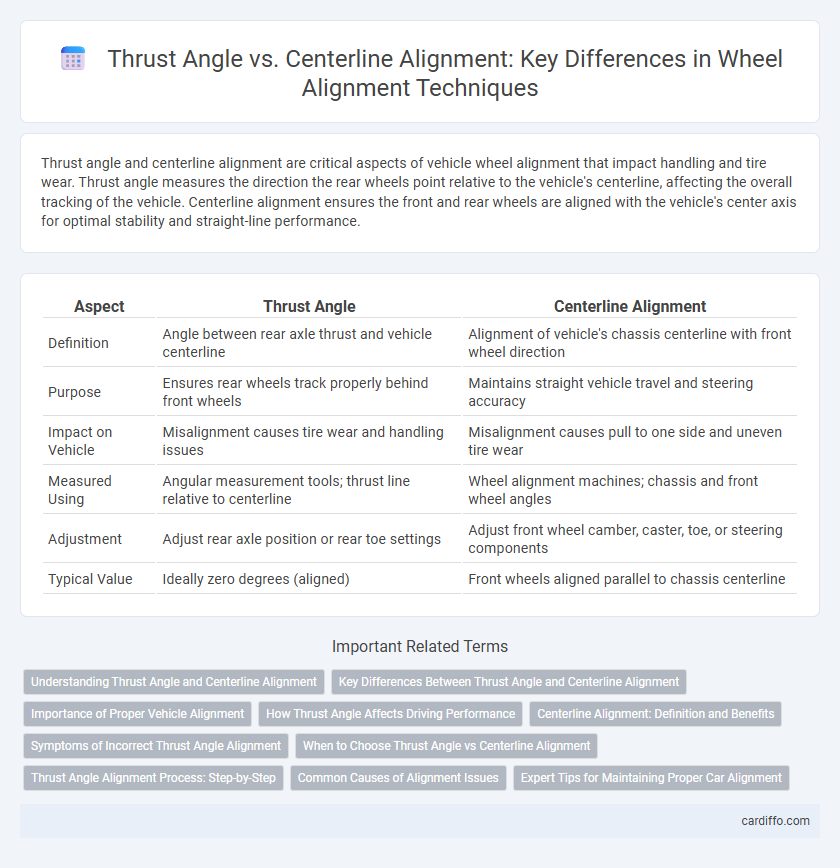Thrust angle and centerline alignment are critical aspects of vehicle wheel alignment that impact handling and tire wear. Thrust angle measures the direction the rear wheels point relative to the vehicle's centerline, affecting the overall tracking of the vehicle. Centerline alignment ensures the front and rear wheels are aligned with the vehicle's center axis for optimal stability and straight-line performance.
Table of Comparison
| Aspect | Thrust Angle | Centerline Alignment |
|---|---|---|
| Definition | Angle between rear axle thrust and vehicle centerline | Alignment of vehicle's chassis centerline with front wheel direction |
| Purpose | Ensures rear wheels track properly behind front wheels | Maintains straight vehicle travel and steering accuracy |
| Impact on Vehicle | Misalignment causes tire wear and handling issues | Misalignment causes pull to one side and uneven tire wear |
| Measured Using | Angular measurement tools; thrust line relative to centerline | Wheel alignment machines; chassis and front wheel angles |
| Adjustment | Adjust rear axle position or rear toe settings | Adjust front wheel camber, caster, toe, or steering components |
| Typical Value | Ideally zero degrees (aligned) | Front wheels aligned parallel to chassis centerline |
Understanding Thrust Angle and Centerline Alignment
Thrust angle measures the direction the rear wheels push the vehicle relative to its centerline, whereas centerline alignment involves aligning the wheels parallel to the vehicle's longitudinal axis for optimal tracking. Proper thrust angle ensures the rear axle is perpendicular to the centerline, preventing the vehicle from drifting or pulling to one side. Centerline alignment maintains balanced tire wear, improved handling, and accurate steering response by ensuring all wheels are aligned parallel to the vehicle's centerline.
Key Differences Between Thrust Angle and Centerline Alignment
Thrust angle alignment measures the rear axle's angle relative to the vehicle's centerline, ensuring the wheels track straight and prevent uneven tire wear. Centerline alignment focuses on aligning the front wheels parallel to the vehicle centerline for proper steering response and handling. The key difference lies in thrust angle addressing rear wheel alignment and vehicle driveline direction, while centerline alignment targets front wheel positioning.
Importance of Proper Vehicle Alignment
Proper vehicle alignment ensures that the thrust angle and centerline alignment are accurately set, preventing uneven tire wear and improving handling precision. Thrust angle alignment corrects the rear wheels' direction to match the vehicle's centerline, maintaining stability and reducing steering pull. Maintaining these alignments promotes safety, enhances fuel efficiency, and extends tire life.
How Thrust Angle Affects Driving Performance
Thrust angle directly influences vehicle handling by determining the rear axle's direction relative to the centerline, affecting straight-line stability and tire wear. Misalignment in the thrust angle causes the vehicle to pull to one side, resulting in uneven tire contact and increased rolling resistance. Proper alignment ensures balanced tire wear, optimal fuel efficiency, and predictable steering response for safer driving performance.
Centerline Alignment: Definition and Benefits
Centerline alignment refers to the precise adjustment of a vehicle's drive shaft and axle along the centerline of the chassis, ensuring optimal power transfer and reducing drivetrain vibrations. Proper centerline alignment improves vehicle stability, enhances tire life by preventing uneven wear, and minimizes mechanical stress on drivetrain components. This alignment method is especially critical for rear-wheel and four-wheel-drive vehicles, where maintaining the drive shaft's correct position relative to the chassis centerline is essential for performance and safety.
Symptoms of Incorrect Thrust Angle Alignment
Incorrect thrust angle alignment causes uneven tire wear, especially on the rear tires, leading to premature tire replacement. Drivers may experience steering wheel off-center and the vehicle pulling to one side, compromising handling and safety. Increased fuel consumption and accelerated suspension component wear often accompany misaligned thrust angles, indicating the need for precise alignment checks.
When to Choose Thrust Angle vs Centerline Alignment
Choose thrust angle alignment when correcting rear wheel positioning to ensure proper tracking and prevent tire wear, especially in vehicles with solid rear axles. Centerline alignment is preferred for precise balancing of the vehicle's overall geometry, focusing on frame and suspension alignment relative to the vehicle's centerline for optimal handling. Selecting between the two depends on the specific misalignment symptoms and drivetrain configuration, ensuring accurate tire wear correction and steering stability.
Thrust Angle Alignment Process: Step-by-Step
Thrust angle alignment involves adjusting the rear wheels so they are parallel with the vehicle's centerline, ensuring optimal vehicle stability and tire wear. The process begins by measuring the thrust angle using alignment equipment, followed by adjusting the rear toe settings until the thrust angle is corrected to zero or manufacturer specifications. Final verification checks confirm that the rear wheels are aligned with the vehicle centerline, promoting proper steering and handling performance.
Common Causes of Alignment Issues
Common causes of thrust angle and centerline alignment issues include worn suspension components, damaged control arms, and improper installation of steering parts. Misalignment often results from hitting potholes, curbs, or uneven road surfaces that disturb the vehicle's geometry. Regular inspections and precise measurements are essential for maintaining correct thrust angle and centerline alignment to ensure optimal tire wear and vehicle handling.
Expert Tips for Maintaining Proper Car Alignment
Maintaining proper car alignment requires prioritizing both thrust angle and centerline alignment to ensure optimal steering and tire wear. Expert tips include regularly checking the thrust angle to confirm the rear wheels are aligned correctly with the centerline, preventing uneven tire wear and handling issues. Using precise alignment tools and scheduling professional inspections every 12,000 miles helps maintain accurate thrust angle and centerline alignment for enhanced vehicle stability.
Thrust Angle vs Centerline Alignment Infographic

 cardiffo.com
cardiffo.com